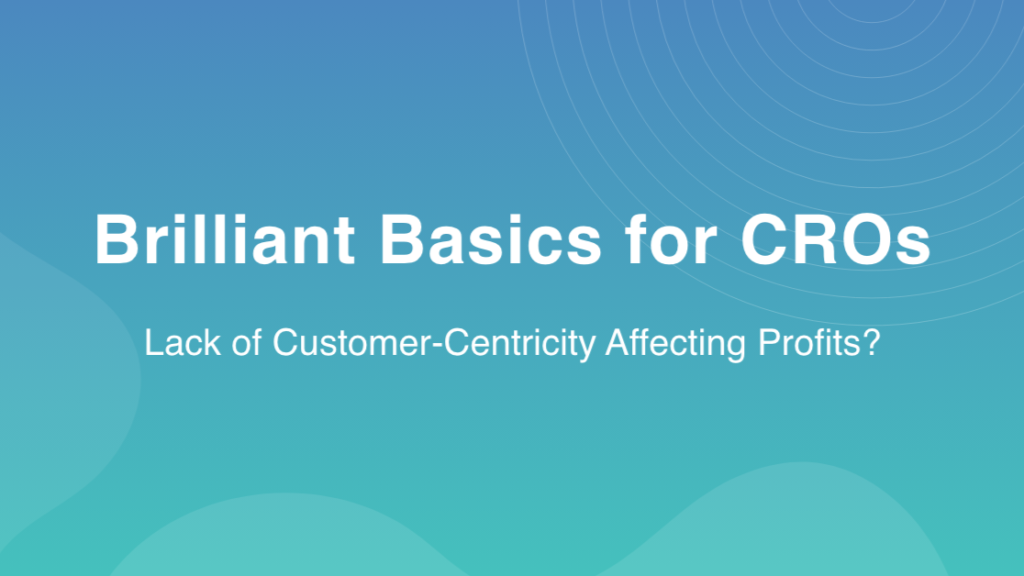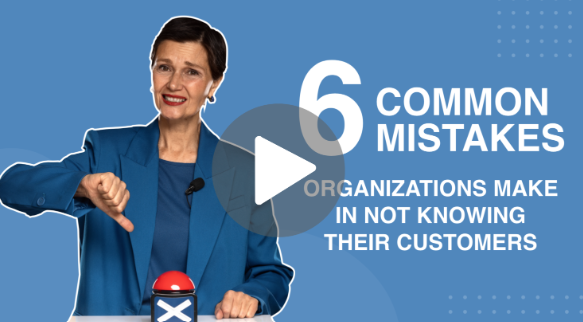Lack of Customer-Centricity Affecting Profits?
“We put the customer at the heart of everything we do” is a slogan advertised proudly on glossy posters and websites across numerous B2B organizations. But is it a hollow promise? A promise designed by the marketing team to tick the ‘customer centricity’ box but without any underpinning foundation, strategy or framework to make it happen?
In a world of innovative, agile competitors leveraging a hatful of disruptive technologies, the cost of failing to meet today’s needs of smarter, more expectant customers can be fatal. Customer centricity really matters!
According to CMO.com “Customer centric companies are 60% more profitable compared to those companies who are not focussed on the customer”

In order for a business to become truly customer centric there must be evidence that they are putting the customer at the core of the company in such a way that it influences the business decisions they make. It includes creating a mindset across a connected organization whereby everyone is focused on creating long-lasting value for the customer. It’s far more than “customer satisfaction”, “customer obsession” or Customer Relationship Management (CRM).
Fred Reichheld, Bain Fellow and an authority on customer loyalty, argues brilliantly in his book “Winning on Purpose” how successful organisations have one primary purpose: to enrich the lives of their customers. And this primary purpose has a measurable correlation to their share price.
I believe that there are a number of critical success factors in creating a customer-centric organization. But, as I’ve travelled the corridors of numerous organisations over the past few years, I’ve witnessed a one common issue that actively PREVENTS customer-centricity: not knowing your customers, the world they live in and how to excite them.
The most successful organizations are perceived by their customers as an indispensable part of their lives. They want a trusted adviser, integral to their business, who not only provides solutions to known problems but also keeps them one step ahead, anticipating opportunities and disruptions. Breaking this down, I’ve observed six specific common mistakes:
❌ 1. Failing to understand customers’ challenges
Before we can decipher what propositions, services and support structures to build we must first understand the challenges customers (and potential customers) are facing and what problems they are trying to solve. We need to immerse ourselves in their environment, look at the world through their eyes and try to imagine being a part of their company. This is not a one-off exercise – in an ever-changing world, it needs to become an ongoing formal and informal activity.
❌ 2. Not participating within the customer ecosystem
It’s vital to establish the ecosystem that customers reside within, i.e. the partners, suppliers and other fast-moving third parties that collaborate together. Between them, these players offer an invaluable source of intelligence regarding the customers’ landscape from alternative and objective perspectives. It also enables the business to gain credibility from being a part of a wider supply team. This learning is not the sole responsibility of the front-line customer-facing teams, but every function within the organization.
❌ 3. Failing to understand who the most important customers are to our business
Without operating with a formal customer segmentation model and understanding what a ‘valuable’ customer looks like, the business won’t be able to focus valuable resources on the sweet spots. Segmentation needs to be growth-orientated and aligned to the opportunity to add value to sweet spot clusters of customers. The worst outcomes include high attrition rates, missed cross-sale opportunities and decreasing profitability of customers.
❌ 4. Failing to teach customers
It’s not enough to simply ‘manage’ customers – front-line individuals must ensure they are perceived as trusted experts by customers. They must provoke customers into action by challenging them about their business and suggesting solutions to problems they may not have even identified themselves. Insight, gleaned from internal and external data, is a massive area of opportunity to unify customer needs and solutions – and in a way that is unique to the relationship. As such, a ‘continual learning’ culture should be fostered to ensure teams keep abreast of customer issues, disrupting forces and industry developments.
❌ 5. Engaging with customers randomly and without coordination
Far too often the method and frequency of customer communications are left lazily to chance. And often these communications conflict. For example, digital content might be created uncoordinated from Marketing; pricing communications may be timed to suit your Finance department; hospitality invitations may be sent ad hoc from executives to random friends; operational information might be sent out independently to Service contacts. Customer engagement must be orchestrated in harmony with the segmentation model. Messages should be timed religiously to maximize (or minimize) their impact. And the variety of today’s converging technologies, via physical and digital channels, needs to be exploited in a way that suits the customer – from simple ‘transactional’ styles (e.g. online) right through to executive-sponsored, face-to-face engagement.
❌ 6. Failing to bring customers ‘inside your tent’
A vital shortcut to understanding the needs of the market while cementing trusting relationships is to include customers in the development of your business or product strategy. Ignoring the opportunity to collaborate on areas such as product innovation, developing market dynamics, disruptive forces etc. creates the risk of building services and solutions that are not relevant. For example, many businesses are fuelling collaborative product innovation by opening up their APIs (Application Programming Interfaces) to customers and partners alike. APIs effectively help businesses integrate more seamlessly with each other by creating a common platform and language, breaking down barriers.
These are just a selection of practical examples that I’ve witnessed – but that are all easily rectified. What blind spots have you discovered in your organisation?
🎯 TAKE THE REVENUE GROW SCORECARD >
🛠️FREE TOOL THIS WEEK – TEAM ROI CALCULATOR
This simple tool, within an Excel spreadsheet, enables you to calculate a set of simple return on investment calculations for a variety of functions (e.g. Sales, Account Management, Marketing, Partners, Management etc.) and total them up into an overall CRO organisation summary. It’s fully adaptable to your own segmentation model and departments.
Need help with the Team ROI Calculator?
Book a 30-minute demonstration call with me!


